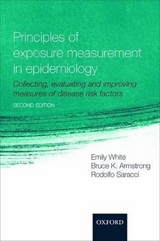
Principles of Exposure Measurement in Epidemiology
Seiten
1992
Oxford University Press (Verlag)
978-0-19-261705-7 (ISBN)
Oxford University Press (Verlag)
978-0-19-261705-7 (ISBN)
- Titel erscheint in neuer Auflage
- Artikel merken
Zu diesem Artikel existiert eine Nachauflage
The objective of much epidemiological research is to relate exposure to external agents to the occurrence of particular diseases. This work covers the principles and techniques of exposure measurement as they relate specifically to causes of non-infectious diseases.
The objective of much epidemiological research is to relate exposure to external agents to the occurrence of particular diseases. The achievement of this objective depends critically on accurate measurement of exposure. This book brings together the principles and techniques of exposure measurement as they relate specifically to causes of non-infectious diseases. In doing so, it draws on experience and results from a number of disciplines, including psychology, survey research, sociology, environmental hygiene, epidemiology and biostatistics, and synthesizes them for direct practical application in epidemiological and related research. The book covers questionnaire design, conducting personal interviews, abstracting information from medical records, use of proxy respondents, and use of biological and environmental measurements. It gives a comprehensive account of measurement error and the estimation of its effects, and the design, analysis, and interpretation of validity and reliability studies. Emphasis is given to the ways in which the validity of measurements can be increased.
Techniques to maximize participation of subjects in epidemiological studies are discussed, and ethical issues relevant to exposure measurement are outlined. The book aims to serve as a handbook for anyone wishing to design or conduct an epidemiological study and can also be used as the text for a graduate course in exposure measurement in epidemiology.
The objective of much epidemiological research is to relate exposure to external agents to the occurrence of particular diseases. The achievement of this objective depends critically on accurate measurement of exposure. This book brings together the principles and techniques of exposure measurement as they relate specifically to causes of non-infectious diseases. In doing so, it draws on experience and results from a number of disciplines, including psychology, survey research, sociology, environmental hygiene, epidemiology and biostatistics, and synthesizes them for direct practical application in epidemiological and related research. The book covers questionnaire design, conducting personal interviews, abstracting information from medical records, use of proxy respondents, and use of biological and environmental measurements. It gives a comprehensive account of measurement error and the estimation of its effects, and the design, analysis, and interpretation of validity and reliability studies. Emphasis is given to the ways in which the validity of measurements can be increased.
Techniques to maximize participation of subjects in epidemiological studies are discussed, and ethical issues relevant to exposure measurement are outlined. The book aims to serve as a handbook for anyone wishing to design or conduct an epidemiological study and can also be used as the text for a graduate course in exposure measurement in epidemiology.
Exposure measurement; methods of exposure measurement; exposure measurement error and its effects; validity and reliability studies; reducing measurement error and its effects; the design of questionnaires; the personal interview; use of records, diaries and proxy respondents; measurements in the human body or its products; measurements in the environment; response rates and their maximization; ethical issues.
| Reihe/Serie | Monographs in Epidemiology & Biostatistics ; No. 21 |
|---|---|
| Zusatzinfo | 22 line drawings, bibliography |
| Verlagsort | Oxford |
| Sprache | englisch |
| Maße | 156 x 234 mm |
| Gewicht | 755 g |
| Themenwelt | Studium ► Querschnittsbereiche ► Epidemiologie / Med. Biometrie |
| ISBN-10 | 0-19-261705-2 / 0192617052 |
| ISBN-13 | 978-0-19-261705-7 / 9780192617057 |
| Zustand | Neuware |
| Haben Sie eine Frage zum Produkt? |
Mehr entdecken
aus dem Bereich
aus dem Bereich
ein überfälliges Gespräch zu einer Pandemie, die nicht die letzte …
Buch | Hardcover (2024)
Ullstein Buchverlage
24,99 €



